Controllable Fabrication of Molecularly Imprinted Microspheres with Nanoporous and Multilayered Structure for Dialysate Regeneration
Abstract
:1. Introduction
2. Materials and Methods
2.1. Materials
2.2. Formation of Multi-Emulsion Droplets
2.3. Preparation of the MISP
2.4. Characterization of MISP
2.4.1. Microscopic Analysis
2.4.2. Swelling Property
2.4.3. Water Absorption
2.4.4. IR Spectral Analysis
2.4.5. Thermal Stability
2.4.6. BET Analysis
2.4.7. Adsorption Study
2.5. Fabrication of MISP-Embedded PDMS Chip
2.6. Numerical Simulation
3. Results and Discussions
3.1. The Phase Separation Process of the Ternary Mixture
3.2. The Cross-Sectional Morphology of MISP
3.3. Properties of MISP
3.4. Studies of Urea Removal of MISP
3.5. Urea Removal in MISP-Integrated Microfluid Chip
4. Conclusions
Supplementary Materials
Author Contributions
Funding
Data Availability Statement
Conflicts of Interest
References
- Gao, R.; Yang, B.; Chen, C.; Chen, F.; Chen, C.; Zhao, D.; Lv, X. Recognition of chronic renal failure based on Raman spectroscopy and convolutional neural network. Photodiagnosis Photodyn. Ther. 2021, 34, 102313. [Google Scholar] [CrossRef]
- Hao, Y.; Yuan, X.; Yan, J.; Pham, M.; Rohlsen, D.; Qian, P.; Cheng, F.; Wang, Y. Metabolomic Markers in Tongue-Coating Samples from Damp Phlegm Pattern Patients of Coronary Heart Disease and Chronic Renal Failure. Dis. Markers 2019, 2019, 4106293. [Google Scholar] [CrossRef] [Green Version]
- Bikbov, B.; Purcell, C.A. Global, regional, and national burden of chronic kidney disease, 1990–2017: A systematic analysis for the Global Burden of Disease Study 2017. Lancet 2020, 395, 709–733. [Google Scholar] [CrossRef] [Green Version]
- Pittard, J.D. Safety Monitors in Hemodialysis. In Handbook of Dialysis Therapy; Nissenson, A.R., Fine, R.N., Eds.; Elsevier: Philadelphia, PA, USA, 2017; pp. 162–190.e2. [Google Scholar]
- Davenport, A.; Gura, V.; Ronco, C.; Beizai, M.; Ezon, C.; Rambod, E. A wearable haemodialysis device for patients with end-stage renal failure: A pilot study. Lancet 2007, 370, 2005–2010. [Google Scholar] [CrossRef]
- Gura, V.; Macy, A.S.; Beizai, M.; Ezon, C.; Golper, T.A. Technical Breakthroughs in the Wearable Artificial Kidney (WAK). Clin. J. Am. Soc. Nephrol. 2009, 4, 1441–1448. [Google Scholar] [CrossRef] [Green Version]
- Cheah, W.-K.; Sim, Y.-L.; Yeoh, F.-Y. Amine-functionalized mesoporous silica for urea adsorption. Mater. Chem. Phys. 2016, 175, 151–157. [Google Scholar] [CrossRef]
- Kim, J.C.; Ronco, C. Current technological approaches for a wearable artificial kidney. Contrib. Nephrol. 2011, 171, 231–236. [Google Scholar]
- Lehmann, H.D.; Marten, R.; Gullberg, C.A. How To Catch Urea? Considerations on Urea Removal from Hemofiltrate. Artif. Organs 1981, 5, 278–285. [Google Scholar] [CrossRef]
- Wester, M.; van Gelder, M.K.; Joles, J.A.; Simonis, F.; Hazenbrink, D.H.M.; van Berkel, T.W.M.; Vaessen, K.R.D.; Boer, W.H.; Verhaar, M.C.; Gerritsen, K.G.F. Removal of urea by electro-oxidation in a miniature dialysis device: A study in awake goats. Am. J. Physiol. Renal. Physiol. 2018, 315, F1385–F1397. [Google Scholar] [CrossRef] [Green Version]
- Abidin, M.N.Z.; Goh, P.S.; Ismail, A.F.; Said, N.; Othman, M.H.D.; Hasbullah, H.; Abdullah, M.S.; Ng, B.C.; Kadir, S.H.S.A.; Kamal, F. Highly adsorptive oxidized starch nanoparticles for efficient urea removal. Carbohydr. Polym. 2018, 201, 257–263. [Google Scholar] [CrossRef]
- Kameda, T.; Horikoshi, K.; Kumagai, S.; Saito, Y.; Yoshioka, T. Adsorption of urea, creatinine, and uric acid onto spherical activated carbon. Sep. Purif. Technol. 2020, 237, 116367. [Google Scholar] [CrossRef]
- Wilson, L.D.; Xue, C. Macromolecular sorbent materials for urea capture. Appl. Polyer 2013, 128, 667–675. [Google Scholar] [CrossRef]
- Charrier, E.E.; Pogoda, K.; Wells, R.G.; Janmey, P.A. Control of cell morphology and differentiation by substrates with independently tunable elasticity and viscous dissipation. Nat. Commun. 2018, 9, 449. [Google Scholar] [CrossRef] [Green Version]
- Ferreira, L.; Vidal, M.M.; Gil, M.H. Evaluation of poly (2-hydroxyethyl methacrylate) gels as drug delivery systems at different pH values. Int. J. Pharm. 2000, 194, 169–180. [Google Scholar] [CrossRef] [Green Version]
- Calixto, G.; Yoshii, A.C.; Rocha e Silva, H.; Stringhetti Ferreira Cury, B.; Chorilli, M. Polyacrylic acid polymers hydrogels intended to topical drug delivery: Preparation and characterization. Pharm. Dev. Technol. 2015, 20, 490–496. [Google Scholar] [CrossRef]
- Zhang, S.; Wang, X.; Man, J.; Li, J.; Cui, X.; Zhang, C.; Shi, W.; Li, D.; Zhang, S.; Li, J. Histone Deacetylase Inhibitor-loaded Calcium Alginate Microspheres for Acute Kidney Injury Treatment. ACS Appl. Bio Mater. 2020, 3, 6457–6465. [Google Scholar] [CrossRef]
- Park, S.; Lee, S.S.; Kim, S.-H. Photonic Multishells Composed of Cholesteric Liquid Crystals Designed by Controlled Phase Separation in Emulsion Drops. Adv. Mater. 2020, 32, 2002166. [Google Scholar] [CrossRef]
- Wang, Z.; Qiu, T.; Guo, L.; Ye, J.; He, L.; Li, X. Polymerization induced shaping of Pickering emulsion droplets: From simple hollow microspheres to molecularly imprinted multicore microrattles. Chem. Eng. J. 2018, 332, 409–418. [Google Scholar] [CrossRef]
- Sun, H.; Ren, Y.; Tao, Y.; Jiang, T.; Jiang, H. Three-Fluid Sequential Micromixing-Assisted Nanoparticle Synthesis Utilizing Alternating Current Electrothermal Flow. Ind. Eng. Chem. Res. 2020, 59, 12514–12524. [Google Scholar] [CrossRef]
- Chen, X.; Ren, Y.; Liu, W.; Feng, X.; Jia, Y.; Tao, Y.; Jiang, H. A Simplified Microfluidic Device for Particle Separation with Two Consecutive Steps: Induced Charge Electro-osmotic Prefocusing and Dielectrophoretic Separation. Anal. Chem. 2017, 89, 9583–9592. [Google Scholar] [CrossRef]
- Fan, J.-B.; Luo, J.; Luo, Z.; Song, Y.; Wang, Z.; Meng, J.; Wang, B.; Zhang, S.; Zheng, Z.; Chen, X.; et al. Bioinspired Microfluidic Device by Integrating a Porous Membrane and Heterostructured Nanoporous Particles for Biomolecule Cleaning. ACS Nano 2019, 13, 8374–8381. [Google Scholar] [CrossRef] [PubMed]
- Haase, M.F.; Brujic, J.J.A.C. Tailoring of High-Order Multiple Emulsions by the Liquid–Liquid Phase Separation of Ternary Mixtures. Angew. Chem. 2015, 53, 11793–11797. [Google Scholar] [CrossRef] [PubMed]
- Liang, S.; Li, J.; Man, J.; Chen, H.J.L. Mass-Transfer-Induced Multistep Phase Separation in Emulsion Droplets: Toward Self-Assembly Multilayered Emulsions and Onionlike Microspheres. Langmuir 2016, 32, 7882–7887. [Google Scholar] [CrossRef] [PubMed]
- Jakubczyk, D.; Kolwas, M.; Derkachov, G.; Kolwas, K.; Zientara, M. Evaporation of Micro-Droplets: The “Radius-Square-Law Revisited”. Acta Phys. Pol. A 2012, 122, 709–716. [Google Scholar] [CrossRef]
- Shirajuddin, S.S.M.; Ratnam, C.T.; Hussin, K.; Shukri, N.A.; Ishak, N.S. Quantification of Tripropylene Glycol Diacrylate grafted onto Waste Tire Dust from Fourier Transform Infrared Spectroscopy. Mater. Today Proc. 2020, 29, 63–67. [Google Scholar] [CrossRef]
- Yi, X.; Xu, Z.; Liu, Y.; Guo, X.; Ou, M.; Xu, X. Highly efficient removal of ur’’anium(vi) from wastewater by polyacrylic acid hydrogels. RSC Adv. 2017, 7, 6278–6287. [Google Scholar] [CrossRef] [Green Version]
- Singh, R.; Pal, D.; Mathur, A.; Singh, A.; Krishnan, M.A.; Chattopadhyay, S. An efficient pH sensitive hydrogel, with biocompatibility and high reusability for removal of methylene blue dye from aqueous solution. React. Funct. Polym. 2019, 144, 104346. [Google Scholar] [CrossRef]
- Lewis, P.C.; Graham, R.R.; Nie, Z.; Xu, S.; Seo, M.; Kumacheva, E. Continuous Synthesis of Copolymer Particles in Microfluidic Reactors. Macromolecules 2005, 38, 4536–4538. [Google Scholar] [CrossRef]
- Abid, C.K.V.Z.; Jain, S.; Jackeray, R.; Chattopadhyay, S.; Singh, H. Formulation and characterization of antimicrobial quaternary ammonium dendrimer in poly(methyl methcarylate) bone cement. J. Biomed. Mater. Res. Part. B 2017, 105, 521–530. [Google Scholar] [CrossRef]
- Chen, Q.; Yu, H.; Wang, L.; Abdin, Z.-u.; Yang, X.; Wang, J.; Zhou, W.; Zhang, H.; Chen, X. Synthesis and characterization of amylose grafted poly(acrylic acid) and its application in ammonia adsorption. Carbohydr. Polym. 2016, 153, 429–434. [Google Scholar] [CrossRef]
- Witono, J.R.; Marsman, J.H.; Noordergraaf, I.-W.; Heeres, H.J.; Janssen, L.P.B.M. Improved homopolymer separation to enable the application of 1H NMR and HPLC for the determination of the reaction parameters of the graft copolymerization of acrylic acid onto starch. Carbohydr. Res. 2013, 370, 38–45. [Google Scholar] [CrossRef] [PubMed]
- Chen, H.; Bian, F.; Sun, L.; Zhang, D.; Shang, L.; Zhao, Y. Hierarchically Molecular Imprinted Porous Particles for Biomimetic Kidney Cleaning. Adv. Mater. 2020, 32, 2005394. [Google Scholar] [CrossRef] [PubMed]
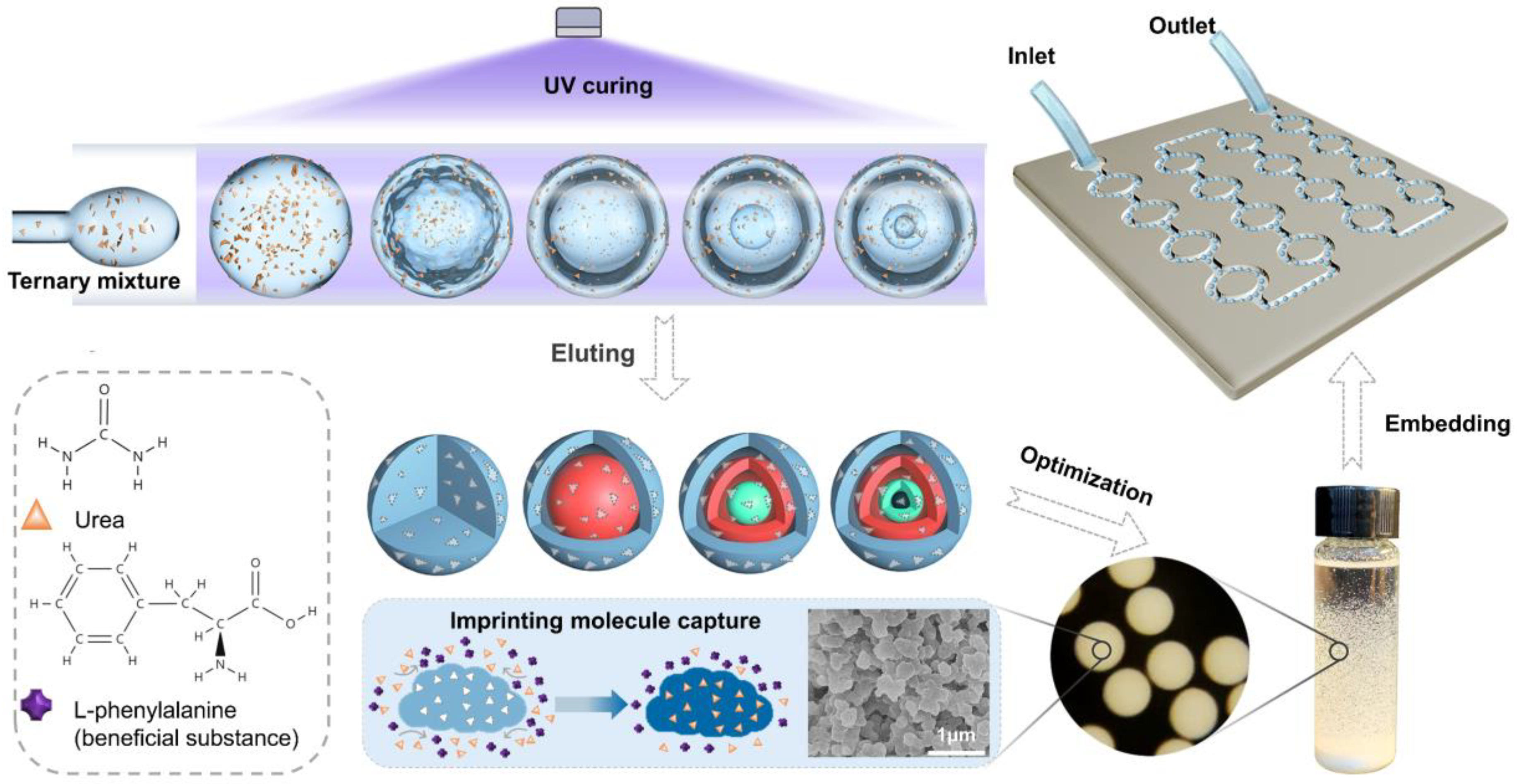
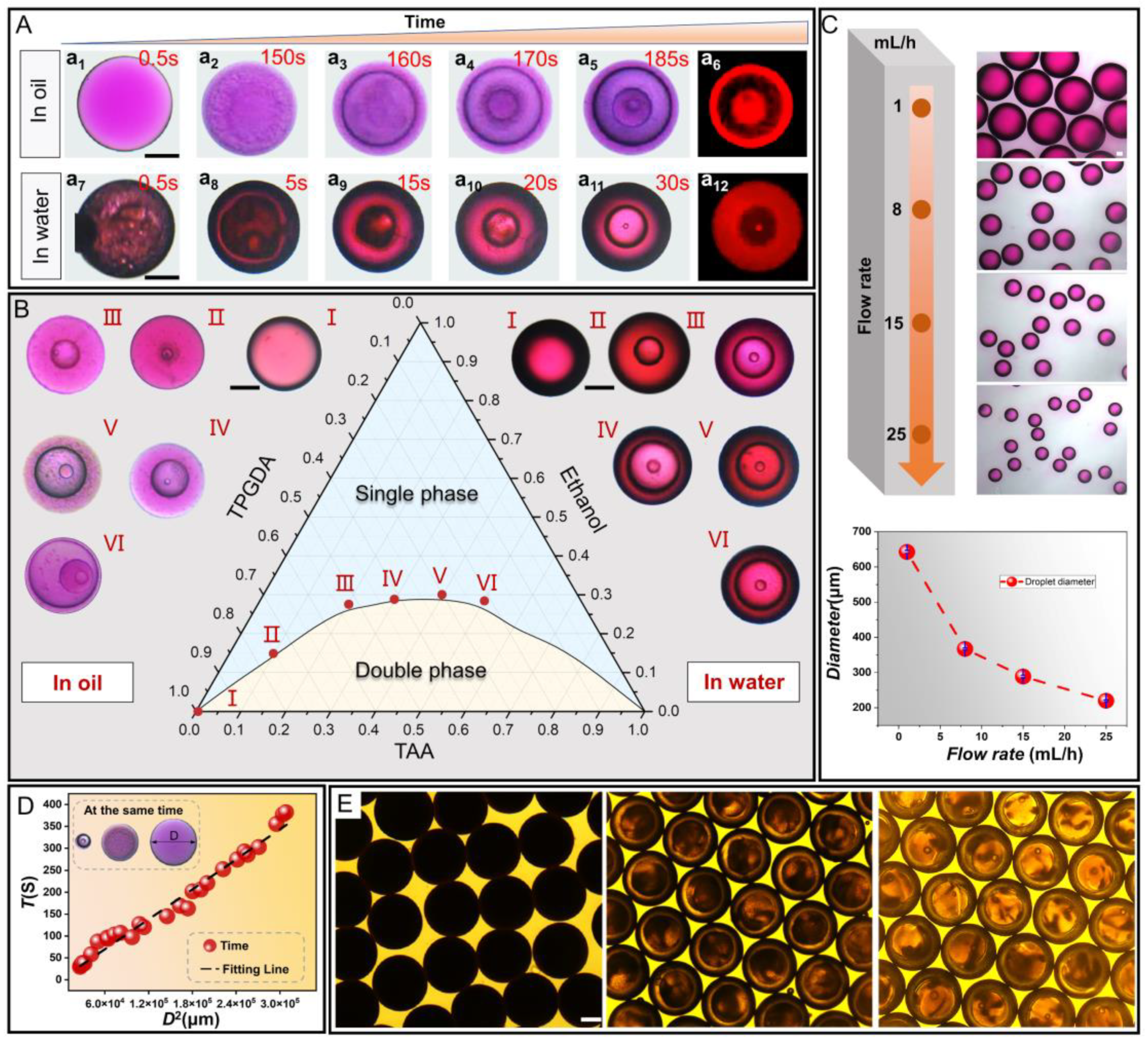
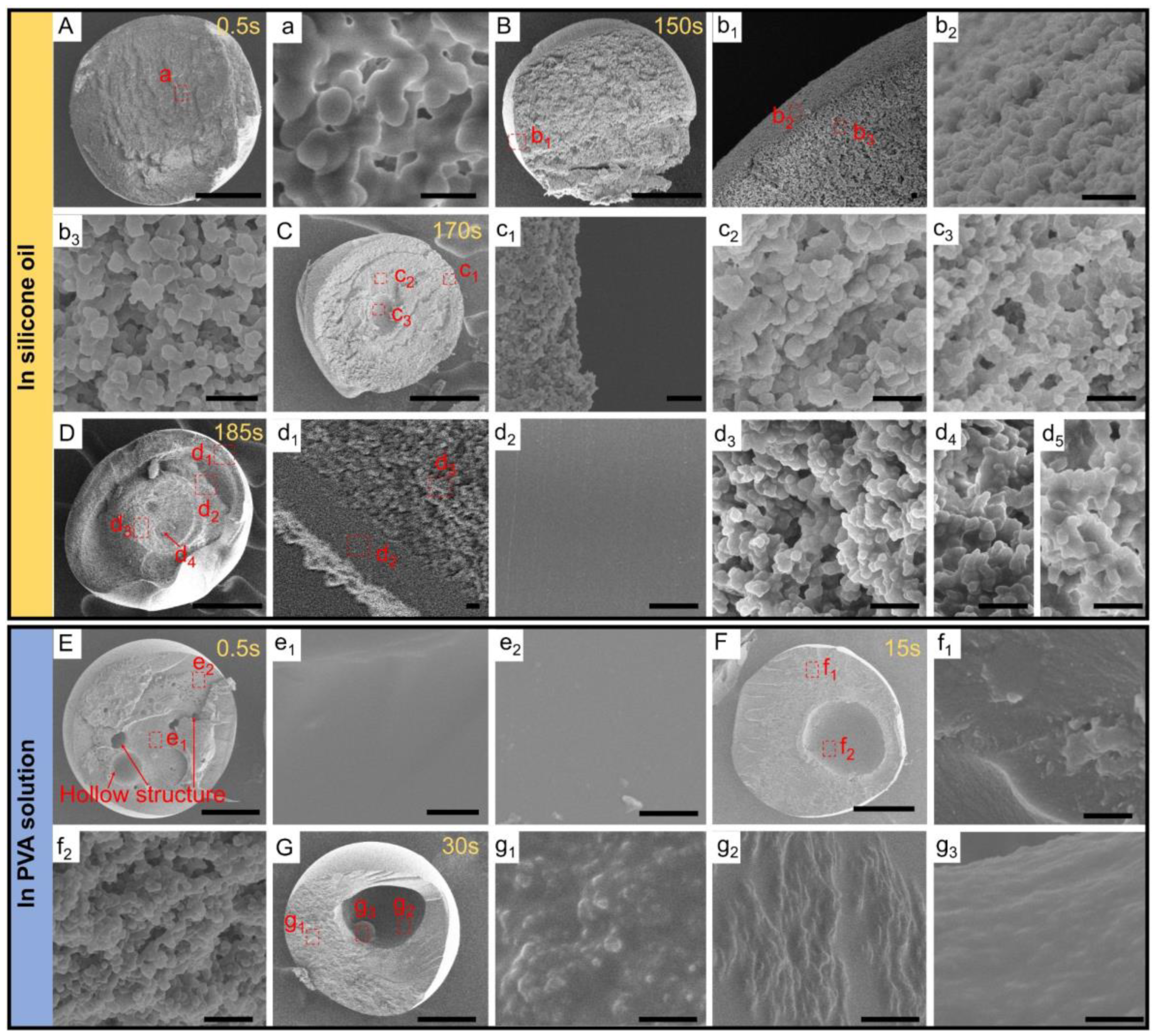
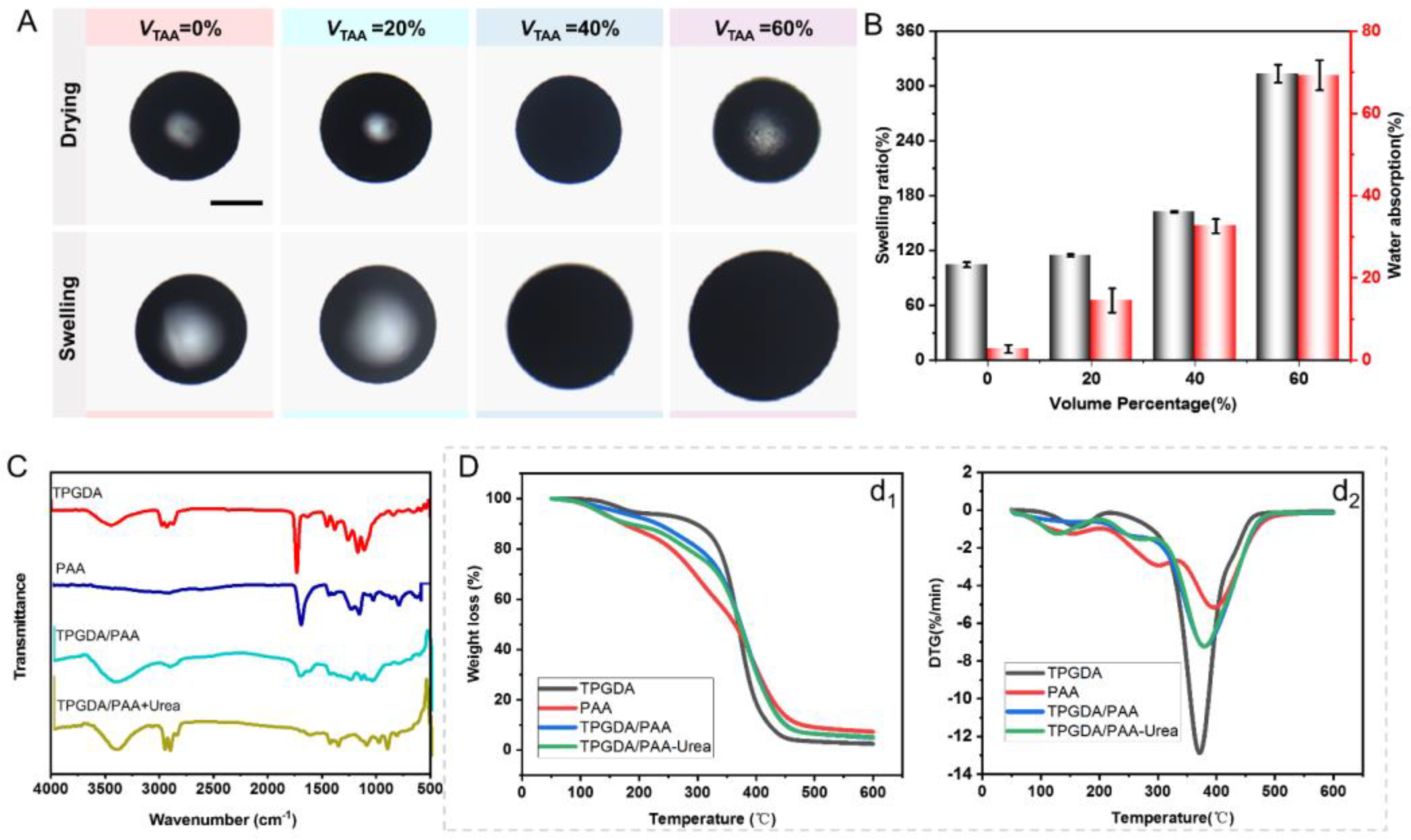
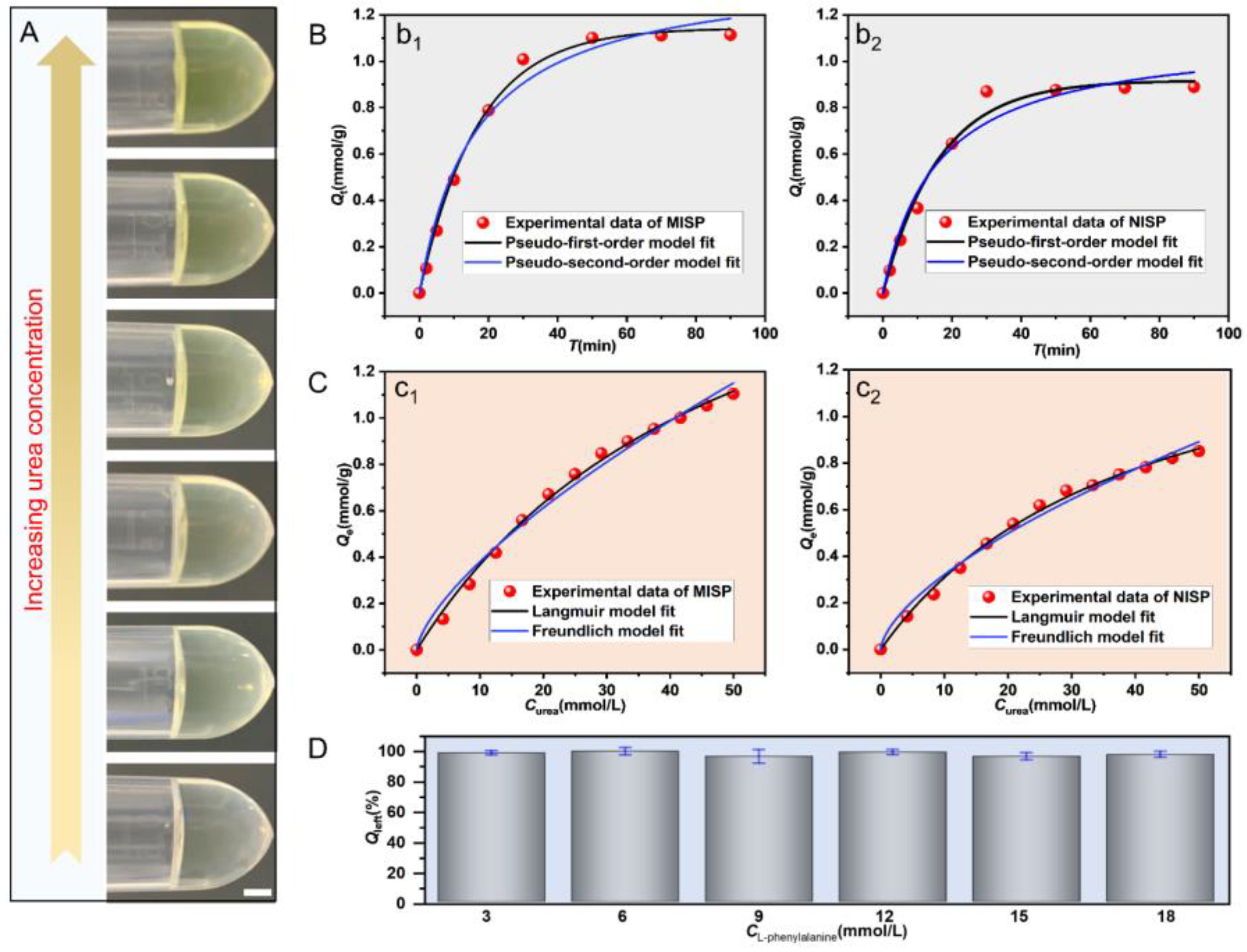
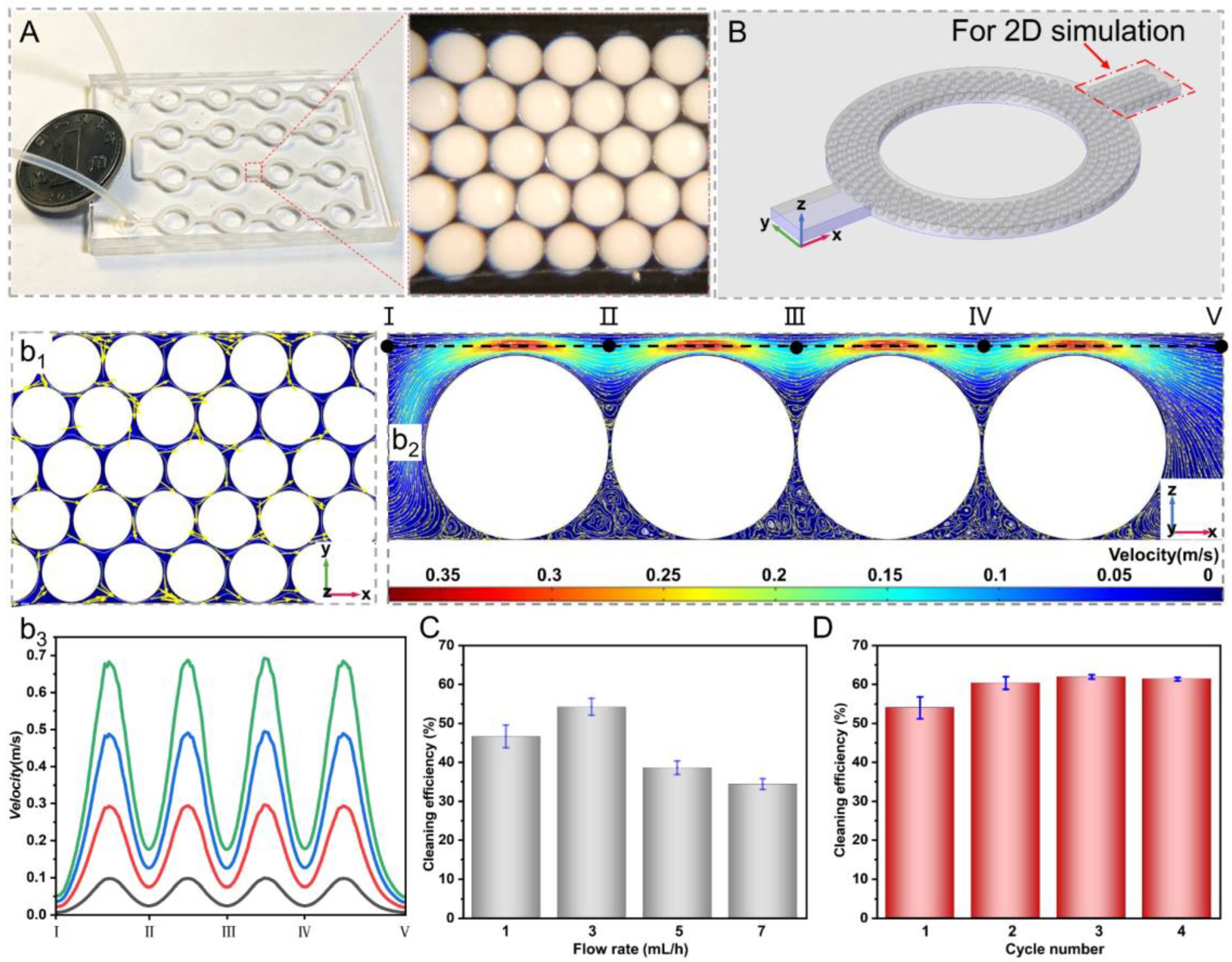
Publisher’s Note: MDPI stays neutral with regard to jurisdictional claims in published maps and institutional affiliations. |
© 2022 by the authors. Licensee MDPI, Basel, Switzerland. This article is an open access article distributed under the terms and conditions of the Creative Commons Attribution (CC BY) license (https://creativecommons.org/licenses/by/4.0/).
Share and Cite
Wu, H.; Zhang, S.; Liu, L.; Ren, Y.; Xue, C.; Wu, W.; Chen, X.; Jiang, H. Controllable Fabrication of Molecularly Imprinted Microspheres with Nanoporous and Multilayered Structure for Dialysate Regeneration. Nanomaterials 2022, 12, 418. https://doi.org/10.3390/nano12030418
Wu H, Zhang S, Liu L, Ren Y, Xue C, Wu W, Chen X, Jiang H. Controllable Fabrication of Molecularly Imprinted Microspheres with Nanoporous and Multilayered Structure for Dialysate Regeneration. Nanomaterials. 2022; 12(3):418. https://doi.org/10.3390/nano12030418
Chicago/Turabian StyleWu, Hongchi, Shanguo Zhang, Lu Liu, Yukun Ren, Chun Xue, Wenlong Wu, Xiaoming Chen, and Hongyuan Jiang. 2022. "Controllable Fabrication of Molecularly Imprinted Microspheres with Nanoporous and Multilayered Structure for Dialysate Regeneration" Nanomaterials 12, no. 3: 418. https://doi.org/10.3390/nano12030418





